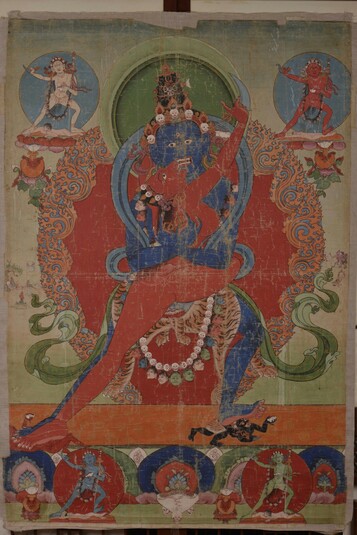
Item: Chakrasamvara (Buddhist Deity)
| Origin Location | Tibet |
|---|---|
| Lineages | Kagyu, Karma (Kagyu) and Buddhist |
| Material | Ground Mineral Pigment on Cotton |
| Collection | Private |
Classification: Deity
The Meditational Deity Sahaja Heruka Chakrasamvara
Chakrasamvara (Tibetan: 'khor lo bde mchog. English: the Wheel of Bliss). Chakrasamvara is the principal deity of the most important Sanskrit Tantra text of the Anuttarayoga Wisdom (mother) classification of the Vajrayana Buddhist Tradition. Chakrasamvara can also be included amongst the most popular deities in Tibetan Tantric Buddhism, the Himalayan region and Tibet, after the 11th century. His purpose and function in the Buddhist Vajrayana religious system is as a model for meditation practice employed by serious Tantric practitioners. There is a vast corpus of literature on the subject of Chakrasamvara. The original source material is written in the Indian Sanskrit language with dozens of Sanskrit commentaries and hundreds of later Tibetan commentaries, including ritual texts, dance performance instruction, and meditation manuals, all written in the Tibetan language.
This form of the deity is known as Sahaja Heruka Chakrasamvara. He appears in a simplified form with only one face and two arms embracing the consort Vajrayogini. In some ritual texts she is referred to as Vajra Varahi, however her most common name is Vajrayogini, or Vajra Dakini. The colour of Chakrasamvara is blue and Vajrayogini is red. Their general mood and appearance is semi-peaceful and semi-wrathful.
"Chakrasamvara, blue in colour, the right foot is extended pressing on red Kalaratri and the left drawn in [pressing] on black Bhairava. With one face and two hands, three eyes, the right hand holds a vajra and the left a bell; embracing the consort, with a crown of five dry human heads as a crown, a necklace of fifty wet, and adorned with the six bone ornaments. [Chakrasamvara is] embraced by the consort Vajravarahi, red in colour, with one face and two hands. The right hand holds a curved knife pointing to the ten directions. The left holds a skullcup filled with the five nectars and embraces the Father. [She is] adorned with a crown of five dry human heads, a [necklace] of fifty dry [heads] and the five bone ornaments." (Jamyang Kyentse Wangpo, 1820-1892).
At the four corners surrounding Chakrasamvara and consort are the four principal retinue figures called 'dakini.' Each figure has one face and two arms, a unique colour, standing with the proper right leg straight and the left leg bent. The names of the four Dakini are: red Khandaroha, green Lama, yellow Rupini, and blue Dakini. In the four intermediate directions are four gold vases each topped with a white skull cup. (The names of each of the four retinue figures are written on the reverse of the painting in Tibetan script).
The meditational deity Chakrasamvara is common to all the New Schools of Himalayan and Tibetan Buddhism (Sarma Traditions: Sakya, Kagyu, Jonang and Gelug). Within the Gelug School the deity is commonly referred to as Heruka. Within the other three schools the term 'heruka' refers to a male meditational deity of the Anuttarayoga classification when appearing in a simplified one face and two-armed appearance. The various deities of Hevajra, Guhyasamaja, Kalachakra, Vajrabhairava and Chakrasamvara all have simplified 'heruka' deity appearance. Among the many different traditions and mandalas of Chakrasamvara practice, this form with one face and two-arms first entered Tibet with the great translator Rinchen Zangpo in the 11th century. Other traditions and lineages of the two-armed form of Heruka Chakrasamvara such as the tradition of Mitra Yogin followed later.
The general style of both the forms of the deity figures and the painting composition is common to the Palpung Monastery located in the Kham region of East Tibet. The specific art style is a combination of Khyenri (style) figures and an open uncluttered minimalist landscape derived from the borrowing of Chinese landscape composition. In the most general way of describing the overall style and composition of the painting then it can be said that it follows a Kham painting style (Khamdri). In current Tibetan popular culture this type of painting is most often referred to, erroneously, as Karma Gardri after the painting style of Tsurphu Monastery and the famous traveling tent encampments of the Karmapa Lamas of Tibet.
Because of the size of the painting it was likely created to hang as a mural-like composition in a temple. There are quite possibly other works created with the same size and related subject belonging to this group, however, at this time no other paintings have yet been identified.
(Written for the publication and exhibition catalogue: Exhibition of Quintessence of Returning Tibetan Cultural Relics from Oversea. Beijing, China, July 2012).
Jeff Watt, June 30th, 2012
Numbered Schematic: 1. Chakrasamvara, Sahaja Heruka 2. Vajra Dakini, Vajrayogini 3. Khandaroha 4. Lama 5. Dakini 6. Rupini 7. Kalaratri 8. Bhairava A. Vase & skull cup B. Vase & skull cup C. Vase & skull cup D. Vase & skull cup
Reverse of Painting
Special Features: (Printed script (Uchen), includes "Om Ah Hum" inscription)
View other items in the Thematic Set: Collection: Private 10

